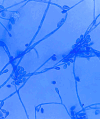Clinical features and antifungal treatment of invasive Scedosporium boydii infection: report of a case and literature overview
- PMID: 39425230
- PMCID: PMC11490084
- DOI: 10.1186/s12941-024-00754-8
Clinical features and antifungal treatment of invasive Scedosporium boydii infection: report of a case and literature overview
Abstract
Objective: This study aims to present a case of persistent mycetoma caused by Scedosporium boydii and undertake a systematic literature overview to elucidate the clinical characteristics and antifungal treatment exhibited by such patients.
Methods: We report the case of a 24-year-old female who sustained a Scedosporium boydii infection in her right foot over a decade ago following a nail puncture. Concurrently, a comprehensive literature overview was conducted on PubMed, focusing on documented cases of Scedosporium boydii infections with the intent of extracting relevant clinical data.
Results: Our analysis revealed that post-transplantation, trauma, near drowning, corticosteroid administration, and prior surgical history were the main risk factors for Scedosporium boydii infection. Prevalent infection sites included skin/bone tissues, the central nervous system, and ocular regions. Among the 49 patients identified, 24 received itraconazole therapy and 25 received voriconazole, with no significant difference in patient outcomes (P = 0.158). Of these, 12 patients experienced treatment failure. Notably, prolonged antifungal treatment duration was identified as a protective factor against mortality in Scedosporium boydii infections [P = 0.022, OR(95%CI): 0.972(0.949-0.996)]. Conversely, a history of post-transplantation emerged as a potential risk factor for mortality[P = 0.046, OR(95%CI): 7.017(1.034-47.636)].
Conclusion: While uncommon, Scedosporium boydii infections carry a significant burden of morbidity and adverse outcomes. Heightened clinical vigilance is warranted in individuals presenting with risk factors for this pathogen. Timely and effective antifungal intervention is crucial, with both voriconazole and itraconazole demonstrating positive treatment outcomes for Scedosporium boydii infection. Therefore, prioritizing these antifungal agents should be considered a key therapeutic strategy in the management of this patient population.
Keywords: Scedosporium Boydii; Antifungal therapy; Clinical features; Fungal infection; Itraconazole; Voriconazole.
© 2024. The Author(s).
Conflict of interest statement
The authors declare no competing interests.
Figures
References
-
- Kaltseis J, Rainer J, De Hoog GS. Ecology of Pseudallescheria and Scedosporium species in human-dominated and natural environments and their distribution in clinical samples. Med Mycol. 2009;47(4):398–405. - PubMed
-
- Panackal AA, Marr KA. Scedosporium/Pseudallescheria infections. Semin Respir Crit Care Med. 2004;25(2):171–81. - PubMed
-
- Schwarz C, Brandt C, Melichar V, Runge C, Heuer E, Sahly H, et al. Combined antifungal therapy is superior to monotherapy in pulmonary scedosporiosis in cystic fibrosis. J Cyst Fibros. 2019;18(2):227–32. - PubMed
-
- Pihet M, Carrere J, Cimon B, Chabasse D, Delhaes L, Symoens F et al. Occurrence and relevance of filamentous fungi in respiratory secretion s of patients with cystic fibrosis–a review. Med Mycol.47(4):387–97. - PubMed
-
- Johnson LS, Shields RK, Clancy CJ. Epidemiology, clinical manifestations, and outcomes of Scedosporium infections among solid organ transplant recipients. Transpl Infect Dis. 2014;16(4):578–87. - PubMed
Publication types
MeSH terms
Substances
LinkOut - more resources
Full Text Sources


